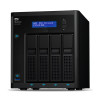Western Digital My Cloud PR4100 User Manual - Page 88
Remote Server, Port Forwarding, Active Directory
 |
View all Western Digital My Cloud PR4100 manuals
Add to My Manuals
Save this manual to your list of manuals |
Page 88 highlights
CONFIGURING SETTINGS Active Directory Enabling this function allows your My Cloud device to join an existing Windows domain. Active Directory is disabled by default. 1. To enable/disable Active Directory, click the toggle button. The Active Directory Settings screen appears. 2. Enter the following information: User Name Password Domain Name DNS Server Enter the Active Directory server account name. Enter the Active Directory server password. Enter the fully qualified name (FQDN) of the Active Directory to join. Enter the Domain Name System (DNS) Server IP address. 3. Review the information on the screen, then click Apply. LLTD This enables/disables the Link Layer Topology Discovery (LLTD) protocol. Select this option to enable LLTD on your network for enhanced network discovery and diagnostics on Microsoft Windows machines. To enable/disable LLTD, click the toggle button. Remote Server The Remote Server section of the Network screen allows you to enable your My Cloud device to act as a remote server, allowing you to back up shares from another compatible My Cloud on the LAN or WAN. Note: To see your My Cloud device over the Internet, ensure that you've added port forwarding rules for both SSH and Remote Backup services. (See "Network Services" on page 76.) To enable Remote Server: 1. Click the toggle button to ON. The Remote Server screen appears. 2. Enter a backup Password to enable remote backups. 3. Click Apply. The system updates and the Remote Server is enabled. Port Forwarding The Port Forwarding section of the Network screen allows you to manage your connections to particular services by assigning default or custom port numbers. For additional information on Port Forwarding, click Learn More to see Knowledge Base Answer ID 8526. MY CLOUD USER MANUAL 82















